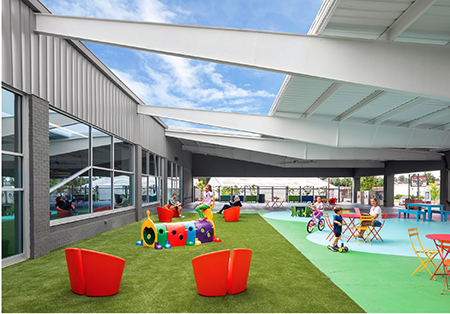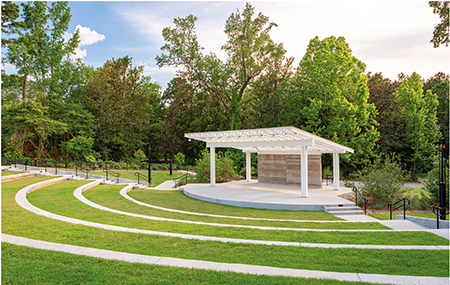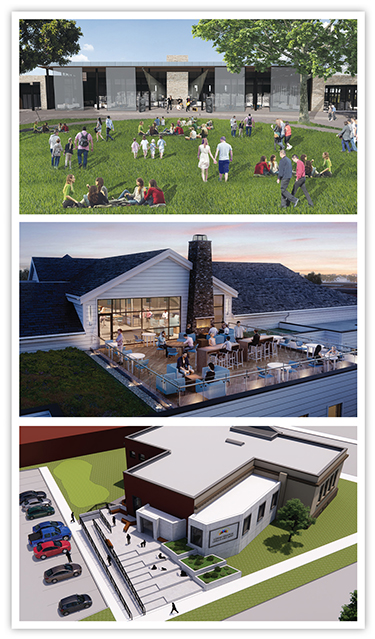Inside Out: Extending the Library's Outdoor Space Footprint
Even before the pandemic, outdoor spaces on library grounds were trending. Now, although the vaccine rollout is well underway, it will likely be fall at the earliest before most libraries resume indoor programming. What was a nice-to-have luxury has become the only game in town.
 COVID-19 has made the value of fresh air very apparent. Even before the pandemic, outdoor spaces on library grounds were trending. Now, although the vaccine rollout is well underway, it will likely be fall at the earliest before most libraries resume indoor programming. What was a nice-to-have luxury has become the only game in town. Plus, in between organized programs, they increase the usable space and reduce the density of patrons indoors, making this the perfect time to consider creating or improving outdoor programming spaces. Even after all the lockdowns are over, outdoor spaces will remain useful for more than preparing for the next pandemic, allowing patrons to enjoy the natural environment while having access to library amenities.
COVID-19 has made the value of fresh air very apparent. Even before the pandemic, outdoor spaces on library grounds were trending. Now, although the vaccine rollout is well underway, it will likely be fall at the earliest before most libraries resume indoor programming. What was a nice-to-have luxury has become the only game in town. Plus, in between organized programs, they increase the usable space and reduce the density of patrons indoors, making this the perfect time to consider creating or improving outdoor programming spaces. Even after all the lockdowns are over, outdoor spaces will remain useful for more than preparing for the next pandemic, allowing patrons to enjoy the natural environment while having access to library amenities.
|
OPTIONS FOR AMENITIES AND PROGRAMS |
Since each library is different, there is no one-size-fits-all outdoor programming area. Considering questions like these can help narrow the focus of how an exterior library space should be designed:
- Is it an extension of the library’s indoor spaces intended for quiet reading, studying, or relaxation?
- Is it a community resource available when the library is closed, similar to a park, or is it fenced in as a private part of the library?
- Are there amenities that can be tied into programs that use the outdoors (trails, gardens, wilderness, etc.)?
- If it will be used for programs, what type are they and what are their needs?
- Will the space be rentable to raise funds for the library?
Narrowing the purpose of an outdoor programming area and understanding the activities and uses for this space will determine the design elements and approach needed to accomplish the library’s goals.
OVERHEAD COVERING, LIGHTING, AND VISIBILITY
The location of the outdoor programming space in relation to the sun should be taken into account during planning. For example, a west-facing orientation might result in uncomfortable afternoon sun angles, making afternoon and early evening programs difficult.
Providing shade and protection from the elements are strategies to maximize a space’s usefulness and may include:
- Trees, foliage, and landscaping
- Tensile canopy structures with fabric-based shades
- Permanent roof structures
Trees and foliage can be aesthetically pleasing choices that add value by bringing a library’s natural surroundings into play, as they did at Georgia’s Hogansville Public Library. If they don’t already exist, however, it may take years for them to mature and even then, they don’t always offer sufficient shade. Trees will also attract birds, bees, and other insects, which could present maintenance issues or concerns for those with allergies. That said, outdoor library spaces without trees and landscaping often feel austere and uninviting.
Tensile canopy structures can be affordable, come in a variety of shapes and sizes, and offer a flexible solution, as they do at the State College of Florida. However, while fabric shades suspended from a trellis or cables can provide overhead protection from sunlight, they don’t usually protect from rain or other inclement weather.
Permanent overhead roof structures that shed water are the best protection from the elements due to their durability and effectiveness. While these can be expensive, some outdoor programs warrant this level of certainty and can make scheduling less susceptible to weather conditions.
 |
OPEN TO FUN Outdoor spaces at the Richland Library, designed by McMillan Pazdan Smith in association with Boudreaux, welcome adults and kids, play, and relaxation through a variety of bright colored, socially distanced fixtures. The detached overhang allows light into the building’s windows while still providing shade. Photo © 2020 Kris Decker/Firewater Photography |
TEMPERATURE CONTROL AND AIRFLOW
To further protect patrons from the elements, fans and air misters can be used to keep cool in temperate climates. Likewise, propane-powered radiant space heaters, commonly used in outdoor seating environments at restaurants, work well in colder areas.
Fire pits are very popular and another way to keep warm and enhance the space’s ambiance. Just be sure to check local fire codes first for any limitations.
SOUND MITIGATION
The level of sound mitigation required, if any, usually depends on the library’s surroundings. For instance, if there is a nearby road or highway, designers may choose to use walls or other structures to reduce the decibel level of the traffic noise. South Carolina’s Richland Library, for example, uses fencing. While it’s a common belief that trees block or reduce sound, landscaping is not very effective at reducing background noise—walls and the use of mass are the best way to block unwanted noise pollution.
Sometimes it is easier or more practical to mask rather than block unwanted environmental background noise. Water features and/or circulating fountains can provide white noise, which instills a sense of calm and peacefulness. Another approach is the use of background music. This can be provided through permanent exterior weatherproof speakers, frequently found in theme parks, or portable audio/video equipment stored within the library
SECURITY
The strategy and extent of security measures will largely depend on whether the area is publicly accessible when the library is closed. If the space is fenced in and accessible to patrons only during library hours, stricter security measures make more sense and are easier to achieve.
In either case, measures should be taken to keep children from straying off the property and prevent bad actors from accessing the area. This can be accomplished with fencing or landscaping in conjunction with good lighting. Making a space well-lit and highly visible acts as a deterrent to criminal behavior and is consistent with Crime Prevention Through Environmental Design (CPTED) principles.
All areas of the library’s outdoor programming space should be visible from at least one staff location. It should be designed without dark spaces or nooks where people can hide. Take care to avoid blind corners, large planters, or landscape features that could also serve as hiding places.
If the space is not enclosed and is publicly accessible, libraries will have to decide how to address the use of library materials in that area. Adding material theft detectors at the doors leading to these outdoor spaces can be expensive and obtrusive if they do not already exist.
SEATING
Depending on how secure the space is, designers will need to determine whether the seating is fixed or movable. If it is publicly accessible, fixed seating will help deter overnight theft. Outdoor furniture anchored to the ground can be an effective option and can be easily added to an existing space.
Low walls, on the other hand, can also create permanent seating and be used for programs or performances. If tiered, they can be arranged to create an amphitheater-type configuration, as at the North Cobb branch of the Cobb County Public Library, GA.
Also popular are interactive and stimulating furniture like swings, hammocks, or stationary bikes, the latter often used in corporate settings.
 |
SIT AND STAY Low walls serve as permanent seating for the amphitheater at the Walterboro Discovery Center, SC. Photo By Paul Cheney Photography |
FINISHES
The selection of finish materials should be durable, vandalism-resistant, low maintenance, and easy to clean.
Light colored concrete “flooring surfaces” are most common. They are relatively inexpensive and can be stamped with texture or patterns to improve aesthetics. Soft rubber flooring, however, can be a great choice for children’s activities and play areas, as at the Five Forks branch of the Greenville County Library System, SC. Sometimes, budgets only allow for grass. Manicured lawns can be an affordable solution for providing soft, inviting outdoor surfaces.
Also, keep in mind that certain railing and fencing types have “channels” on their underside that can provide attractive homes for bees, wasps, and other stinging insects and should therefore be avoided.
INTERNET ACCESS
Now that much of the country has spent the better part of a year working or studying remotely, access to a strong Wi-Fi signal is more important than ever. During the pandemic, many libraries extended their Wi-Fi to parking lots and outdoor spaces when they were forced to close to visitors due to COVID-19.
For this reason (in addition broadband equality, access, and the proliferation of personal hand-held device use), outdoor programming spaces should provide access to strong Wi-Fi signals and plenty of power receptacles such as weatherproof outlet covers or freestanding power kiosks.
Libraries are the recognized lifeblood of their communities under normal circumstances. However, the ongoing global pandemic has revealed them to be more vital than ever. For many, their materials and services have been the needed tethers to remain connected in an isolated world. As they slowly and safely reopen to in-person services, with group indoor programming returning last, outdoor programming spaces can and should be leveraged and improved to expand library services, sustain patron wellbeing, and attract new visitors to the library.
David R. Moore II, FAIA, is a principal of McMillan Pazdan Smith, a regional, studio-based design firm with offices in Greenville, Charleston, and Spartanburg, SC; Asheville and Charlotte, NC; and Atlanta, GA. He can be reached at dmoore@mcmillanpazdansmith.com.
The Outside Look: Designing Outdoor Library Spaces for the FutureLibrary architects and designers share how the pandemic has changed their—and their clients’—approach to designing outdoor library spaces for the future“The biggest difference…is that it is no longer seen as a luxury,” Peter Bolek, president of HBM Architects, Chagrin Falls, OH, tells LJ. “Pre-pandemic, many of our clients would consider outdoor spaces but opt not to include them, either as an immediate cost savings or to avoid a long-term upkeep and maintenance plan. Today, almost all of our current projects include outdoor spaces…. Now, the outdoor space is a required program item, not an option, just as prominent as quiet reading rooms, meeting rooms, or maker spaces have been in building programs.” What libraries do with these newly necessary spaces is different too. Libraries are considering “unprecedented types of resources, land use, activities, and partnerships—not just replicating interior library spaces for outdoor use,” says Lyna Vuong, senior design strategist at Margaret Sullivan Studio (MSS), New York.
One case in point, Vuong says, is New Castle County, DE. MSS was originally engaged to create a new facilities master plan, but when COVID-19 hit, the client asked them to instead develop outdoor learning and experience guidelines for all Delaware libraries. MSS met with 30 library directors across the state, for a deep dive into each community’s challenges, opportunities, demographics, histories, and cultures. The project resulted in 30 customized concepts, including arts and farmers markets; drive-in movies; digital learning, vocational, and personal development activities; and storywalks. A subset of these programs has been turned into a starter kit, for ease of adoption. Traci Lesneski, CEO and principal of MSR Design, Minneapolis, offers, as an example of current thinking about outdoor library spaces, her firm’s plan for the L.E. Phillips Memorial Public Library in Eau Claire, WI. Very practical needs (such as drive-up materials drop-off and pick-up) mingle with classic outdoor features (a sculpture walk and reading lawn) and are joined by more unusual concepts, including a “learning landscape” and an outdoor maker court. Outdoor innovation in libraries preceded the pandemic (see “Great Outdoor Spaces” in the Sept. 15, 2017 issue of LJ), but there’s no denying that COVID-19 has driven many libraries not only to prioritize them but also to see their utility through a broader lens. Even as widespread vaccination opens up the possibility of returning to full use of indoor library spaces, we look forward to a bumper crop of creative outdoor projects in 2021 and beyond. —Meredith Schwartz |
RELATED
ALREADY A SUBSCRIBER? LOG IN
We are currently offering this content for free. Sign up now to activate your personal profile, where you can save articles for future viewing










Add Comment :-
Comment Policy:
Comment should not be empty !!!